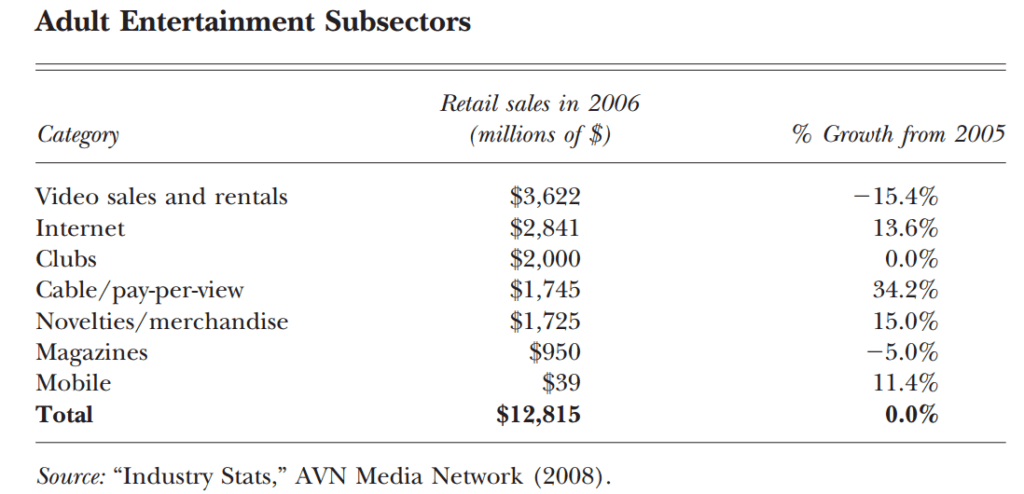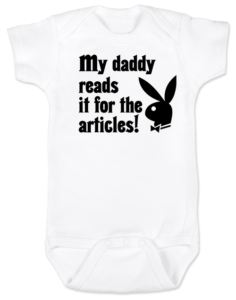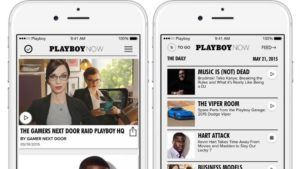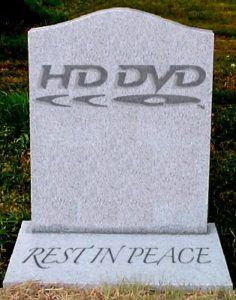Playboy: The Naked Truth

*gasp* yep, I'm talking about porn… bear with me while I bare all about the industry we like to pretend doesn't exist.
Before you get your panties in a twist…
Consider this: pornography has been shown to accelerate, and even dictate, the adoption of technologies. Look to the 1980s, and we see VHS winning out over Betamax as the format for video tapping. Why? The longer recording times of VHS made it the porn industry standard, and with overwhelming volume flowing out of adult entertainment, media mavens were forced to follow suit. [1]
Again in the mid-2000s, the National Association of Broadcasts discussed “several major players in the porn industry going the Blu-Ray route” over HD-DVDs, ultimately convincing mainstream players to invest in the Blu-Ray format. [2] Business Insider even goes so far as to say that the internet itself “would not have found a solid consumer base without porn.” [3] The whole internet?! Owes its success to porn?! Now that’s a panty dropper.
The internet is such a tease: stripping away profits, one click at a time…
As much as porn has driven technology innovation, the digital revolution has caused issues for the industry and many companies have struggled to adapt as free porn floods the internet. In 2006, the internet saw double digit growth, already outpacing spending in more traditional businesses like magazines by nearly three times.

Can the internet really take down an institution like Playboy though?
Um…yes.
The NY Times notes, “Pornographic magazines, even those as storied as Playboy, have lost their shock value,
their commercial value and their cultural relevance.” [6] Playboy’s business model banked on the elusiveness of  naked photos, but flashlights under the sheets have been replaced by the glow of iPhones where porn is on-demand, free, and easily accessible.
naked photos, but flashlights under the sheets have been replaced by the glow of iPhones where porn is on-demand, free, and easily accessible.
Playboy magazine’s circulation dropped from 5.6 million in 1975 to 3 million in 2006 and 0.82 million in 2015. [7] Banking on the adage that men buy Playboy for the articles, the magazine dropped nudity from its website and magazine in 2014 and 2015 respectively. This business model shift to top-notch journalism with artistic photos provided access to social media (which bans sexually explicit content) and additional advertisers, but also edged Playboy into a competitive space with elite brands like The New Yorker. [8]

Playboy’s operating model has expanded beyond the core of publishing magazines; the company now positions playboy.com as “sexy and safe-for-work,” offers iPlayboy for access to every issue of the magazine ever, gives Playboy bunnies Instagram feeds, and pushes a mobile app, Playboy Now, to allow readership across digital channels. [9]
Adding to its business and operating model over the last ten years, Playboy also pursued subscription porn sites like Playboy TV and acquired hardcore porn sites, such as Club Jenna in 2006. [10]
Here’s the sad part of the story: free porn is still winning.
Despite the business model and operational updates seeking to leverage digital solutions, Playboy is still losing ~$6M per year and is up for sale for $500M with no potential buyers. [11] While the non-nudity rebranding quadrupled its website unique users per month to 16 million, over half of Playboy’s money comes from licensing its brand. [12]
Can we save the bunnies?
Playboy is having a full-on identity crisis. Capitalizing on the brand for subscriptions to hardcore porn sites while attempting to shift the magazine to work-appropriate editorial content makes it near impossible for Playboy to disassociate with its erotic image and attract new customer segments to its website, mobile app, and social media. People looking for porn are going to find it for free; people looking for great journalism have plenty of established options that don’t require excuses when the website is open on their computers.
But they still have one edge – the bunnies. Playboy needs to divest its subscription hardcore porn businesses  and return to its 1950s pinup girl roots with a clear and consistent brand message matching their non-nudity move. Then, they need to aggressively manage their bunny brand and expand merchandising, perhaps limiting licensing over time to control product quality. Finally, they need to find their Marilyn Monroe of the 21st century and create a Playboy bunny social media supermodel to keep the brand relevant and cool. Playboy can use these steps to position themselves as a classier, gender-neutral Cosmo magazine, providing the potential to retain male readers while attracting women who want to feel sexy (but not slutty). In the age of #freeporn, Playboy needs to leverage its iconic heritage and go back to basics to win in this digital revolution.
and return to its 1950s pinup girl roots with a clear and consistent brand message matching their non-nudity move. Then, they need to aggressively manage their bunny brand and expand merchandising, perhaps limiting licensing over time to control product quality. Finally, they need to find their Marilyn Monroe of the 21st century and create a Playboy bunny social media supermodel to keep the brand relevant and cool. Playboy can use these steps to position themselves as a classier, gender-neutral Cosmo magazine, providing the potential to retain male readers while attracting women who want to feel sexy (but not slutty). In the age of #freeporn, Playboy needs to leverage its iconic heritage and go back to basics to win in this digital revolution.
[Word count: 798]
Sources
[1] Johnson, Peter (1996). “Pornography Drives Technology: Why Not to Censor the Internet.” Federal Communications Law Journal, 49(1): 217–26. <http://www.repository.law.indiana.edu/cgi/viewcontent.cgi?article=1120&context=fcl>
[2] Mearian, Lucas. “Porn Industry May Decide Battle between Blu-Ray, HD-DVD.” Macworld, 2 May 2006. <http://www.macworld.com/article/1050627/storage/pornhd.html>.
[3] Benes, Ross. “PORN: The hidden engine that drives innovation in tech.” Business Insider, 5 Jul 2013. <http://www.businessinsider.com/how-porn-drives-innovation-in-tech-2013-7>
[4] Edelman, Benjamin (2009). “Red light states: who buys online adult entertainment?” Journal of Economic Perspectives, 23(1): 209–220. <http://people.hbs.edu/bedelman/papers/redlightstates.pdf>
[5] Breslin, Susannah. “The business of porn.” Forbes online, 21 Jan 2013. <http://www.forbes.com/sites/susannahbreslin/2013/01/21/the-business-of-porn/#379d071859b2>
[6] Somaiya, Ravi. “Nudes are old news at Playboy.” The New York Times online, 12 Oct 2015. <http://www.nytimes.com/2015/10/13/business/media/nudes-are-old-news-at-playboy.html?_r=0>
[7] Chemi, Eric. “Playboy magazine, by the numbers.” CNBC online, 11 Dec 2015. <http://www.cnbc.com/2015/12/11/playboy-magazine-by-the-numbers.html>
[8] Powell, Neil. “The real reason Playboy is getting rid of nude pics.” Fortune online, 17 Oct 2015. <http://fortune.com/2015/10/17/playboy-stops-nude-photos/>
[9] Company website. Accessed 16 Nov 2016. <http://www.playboyenterprises.com/playboy-content/>
[10] Spain, William. “Playboy gets more hardcore with new acquision.” Marketwatch, 22 June 2006. <http://www.marketwatch.com/story/playboy-goes-for-more-hardcore-with-new-acquisition>
[11] Helmore, Edward. “Playboy business on sale for $500m – but is there still money in the bunny?” The Guardian, 2 Apr 2016. <https://www.theguardian.com/us-news/2016/apr/02/playboy-business-sale-future>
[12] Somaiya, Ravi. “Nudes are old news at Playboy.” The New York Times online, 12 Oct 2015. <http://www.nytimes.com/2015/10/13/business/media/nudes-are-old-news-at-playboy.html?_r=0>




Really interesting article. I have been thinking about this. I also wonder about the human cost of this change to online and free pornography. Firstly, I wonder if there is a rise in pornography addiction (http://www.apa.org/monitor/2014/04/pornography.aspx) and also I wonder if the people in the industry were more fairly treated beforehand. I imagine that the excess availability is driving down salaries?
Alex, with changes in technology I have also been thinking about the potential increasing human costs caused by pornography and addiction. Neuroscience studies are beginning to converge on the idea that internet pornography can have similar rewiring effects on the brain and its rewards center as long-term physical substance-abuse. (https://www.ncbi.nlm.nih.gov/pmc/articles/PMC4600144/ , http://pornharmsresearch.com/wp-content/uploads/Research_Hilton_Sex-Addiction-as-a-Disease_2015.pdf). As it becomes more accessible across the world (aided first by the internet, then mobile, and now virtual reality), what effect will the proliferation of free pornography have on society? It could be worrisome, especially now that children increasingly have mobile phones. There are various U.K. media outlets that have discussed this recently, so I would be curious to hear if this is something that is being talked about more broadly in the U.K.
I remember hearing about Playboy removing nudity from its magazines, and wondering how that was going to play out for them. Thanks for enlightening me! I never thought I’d think of playboy.com as “sexy and safe-for-work,” but it looks like it’s trying to get there. I think your suggestion for them to re-position themselves as a classier, gender-neutral Cosmo magazine would be a great way to attract a female readership.
Your comment about porn driving the adoption and innovation in technology reminded me of this article I read about the Oculus Rift and virtual reality (http://fortune.com/2015/07/31/porn-virtual-reality/). Apparently “adult entertainment will be the number three driver of all VR content behind movies and games, and the porn VR business will grow into a $1 billion industry by 2020.” I wonder if porn is the motivation behind inventing these new technologies, or if porn merely helps these new technologies be developed and adopted quicker?
Interesting read and great take on a really unique challenge this company is facing in the digital era. Another channel that Playboy is pursuing is to abandon its role as a content provider altogether and to just license the logo for apparel in China, where it is wildly popular as just a cute bunny logo to put on clothes and where most people don’t know about the brand’s roots in the US at all. See http://foreignpolicy.com/2016/02/15/playboy-is-ditching-the-sex-and-betting-on-china/ for an example. As this article describes, though, such a dramatic pivot is also confronting the company with a range of questions about brand image, as it seeks to maintain some perception as a foreign luxury brand despite a profusion of cheap knock-offs.
Very interesting article. Indeed pornography seems a great unique driving force catalyzing technological shift. This article pays tribute to one of human’s strongest drive than can be efficiently used to scale digital shift.
@AGlasner: I agree that this must have led to some dislocations and probably addictive behaviours. As Dominic Pettman hints in his “Love and other technologies : retrofitting eros for the information age” (2006, New York : Fordham University Press), it is quite hard to realize how we are changed by readily available accessible pornography.
In the past, greater efforts were needed to access sexual impulse material. Like in Kubrick’s “Eyes Wide Shut” one needed a password to access orgiastic underworld parties. This was Freud’s Vienna. This was Victorian London.
If under-aged exposure or excessive access can have negative consequences, one can still hope that the pornography cathartic power can serve as a decompression valve for societies.
@Evan: I am not sure that Chinese respect for copyright will be strong enough for Playboy to get enough royalties from bunny licensing. But it is certainly an adjacency worth pursuing. The US Office of the United States Trade Representative placed China on its “priority watch list” for intellectual property rights violations in 2014. Could this help protect the american bunny?
@Matt: Indeed people imagination will be shaped by their access to pornography. https://xkcd.com/598/
Very interesting read on an industry that is suffering the effects of the digital revolution and piracy. I see a clear comparison with other industries that have suffered from piracy before like the books, music and movies industry. So as these industries have tried to fight back by innovating and creating new products that can’t be copied easily, what can Playboy and the Porn Industry do? As you say one thing could be leveraging more in their brand and creating more products that they can sell. It could even go to creating an intimate clothing sub-brand using the “bunny”. On the other hand Playboy could start investing more in R&D and try to create more new sophisticate products that can differentiate them form the other players of the industry, specially the “pirates”, and can motivate consumers to actually pay for something that they can usually obtain for free. For instance, I have heard that some companies are working in the adoption of Virtual Reality, so maybe this would be something that Playboy could be targeting as a new move to save their company from the negative effects of the internet in their business
Interesting post Michelle. I find it difficult to see how Playboy can dissociate itself from its image as a porn magazine to become a “safe-for-work” read. I wonder how viable that re-positioning really is. Perhaps re-branding could be a way of leaving behind that pornographic heritage.
I do however completely agree with your suggestion around finding the Marilyn Monroe of the 21st century as a way of becoming relevant and increasing awareness among customers. I was thinking of who that might be, someone like Emma Watson maybe..
This is a very interesting point of view, which I would like to expand by discussing two other aspects worth thinking about:
First of all, I wondered whether the rise of the feminism had an influence on pornography as the sexualization of women is a popular topic in feminist debates. A magazine, which generates revenue from thematizing sexuality could have problems with this. After researching a bit in the Internet, I found this article of Carrie Pitzulo who describes the rising progressivity of Playboy in terms of feminism:
http://www.jstor.org/stable/pdf/30114220.pdf
Another aspect worth discussing is how the general shift from pornography magazines to the internet affects problematic topics like forced pornography as the demand is steadily growing.
Very interesting article! I agree with your idea of capitalizing on their bunny brand. It still has a lot of value and recall, and it can be a great candidate for the re positioning of “sexy” vs “slutty”. What also scares me is the idea of consumers wanting everything free – especially if its on the internet, and the availability of people willing to give it to them. As we move more towards digitization and services over the internet, do companies have to seriously reconsider their operating and revenue generating models to adapt to this trend?
Interesting read Michelle. I find the disruption to the porn industry to hold many parallels to the disruption in the media industry as a whole. The key difference being that the adult entertainment industry has done a very poor job in protecting it’s intellectual property when compared to the movie, news, and music industries. I’m not sure why that’s the case but it would be interesting to see if they take some lessons from their (better behaved) siblings.
Awesome post, Michelle. I cannot help but think of the parallels with Rdio and the music industry. Because any one can access porn for free from anywhere (albeit maybe on a separate device to protect the main device from viruses) the reference price is zero. Since the reference price is zero, it makes it literally almost impossible to convince viewers to pay for porn. There are even “premium” sites that exist that literally offer unlimited and unfettered access to the ‘hottest’ videos for $1. In this world, I do not see how Playboy can focus on porn at all as an offering, unless it too goes free. And even in that case, it would have to increase spending on its content acquisition strategy, which is a risky game. I agree with your suggestions to try and do a complete rebrand, as newer consumers are less likely to have preconceived notions of what Playboy used to be.